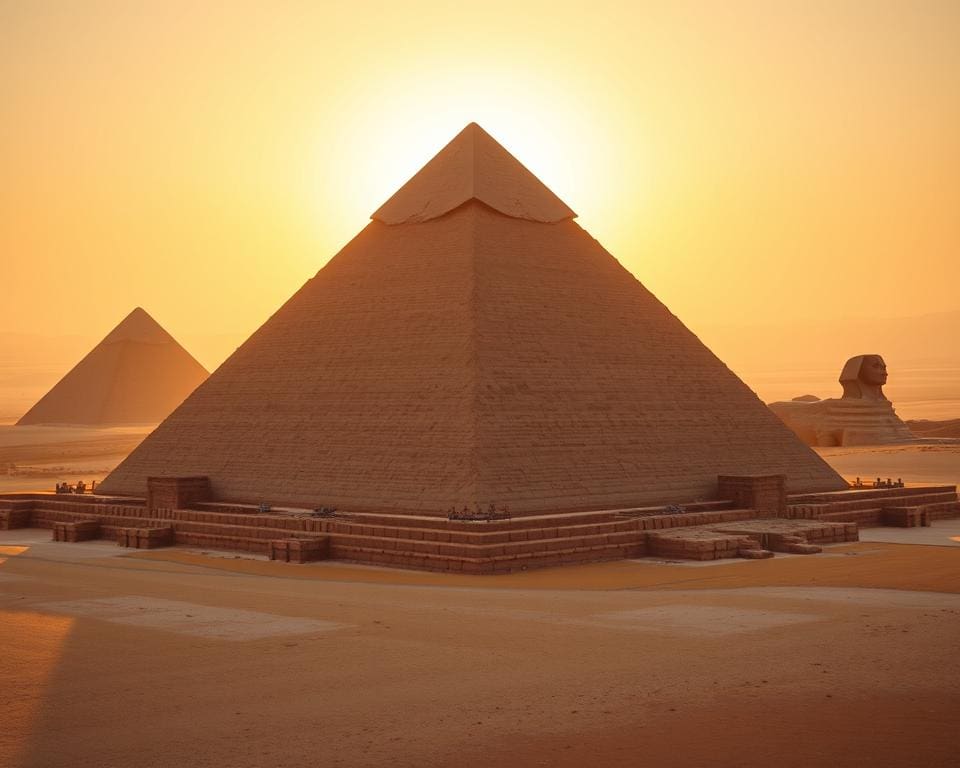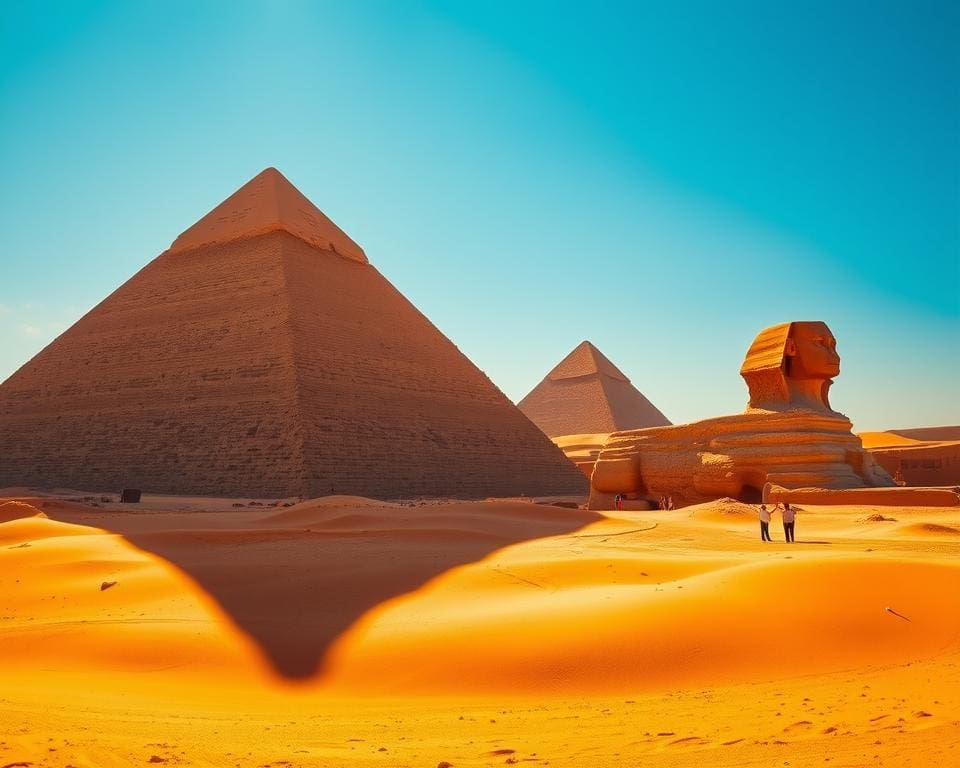The Pyramids of Giza, a majestic testament to ancient Egypt’s architectural prowess, stand as symbols of mystery and grandeur. Dating back to around 2686 BC, these iconic structures are not only remarkable feats of engineering but also UNESCO World Heritage sites that capture the imagination of millions of visitors each year. In this guide, we will uncover the best travel tips to enhance your journey as you learn how to explore the pyramids, delving into their historical significance and the captivating stories they hold. Prepare to embark on an adventure through one of the world’s most fascinating historical landscapes.
Introduction to the Pyramids of Giza
The Pyramids of Giza stand as monumental testaments to the ingenuity and ambition of ancient Egypt. Erected as elaborate tombs for pharaohs, these structures have a rich history that transcends millennia. The three principal pyramids—the Great Pyramid of Khufu, the Pyramid of Khafre, and the Pyramid of Menkaure—were not only feats of engineering but also fascinating embodiments of the societal and religious values of the time.
Constructed primarily from limestone and granite, the Pyramids of Giza highlight the advanced construction techniques employed by the Egyptians. The Great Pyramid, reaching a towering height of approximately 146.6 metres, held the title of the tallest man-made structure for over 3,800 years. This astonishing achievement reflects not just architectural prowess but also a deep significance; these monumental structures served essential purposes in Egyptian burial practices and religious beliefs, acting as gateways to the afterlife for their royal inhabitants.

The significance of these pyramids extends beyond mere physical presence, offering valuable insights into the culture and belief systems of ancient Egypt. Visitors today are left in awe of their enduring mystery and historical resonance, making the Pyramids of Giza an indispensable part of world heritage.
How to explore the pyramids of Giza?
The Pyramids of Giza, masterpieces of ancient engineering, stand as monumental reminders of Egypt’s rich history. Each structure reveals layers of historical significance deeply intertwined with the cultural identity of ancient civilizations. Understanding these aspects enhances the Giza exploration experience, allowing visitors to appreciate the ingenuity behind such iconic landmarks.
Understanding their historical significance
The pyramids served as grand tombs for pharaohs, embodying the profound belief in life after death prevalent in ancient Egyptian culture. This architectural choice reflects not only the importance of the individual sovereign but also the society’s values and religious beliefs. Each pyramid is a testament to the power dynamics and the organisational prowess that defined an era.
The engineering marvels
The engineering techniques utilised in constructing the pyramids are nothing short of remarkable. Builders employed precise measurements and geometric principles, aligning the structures with celestial bodies for astrological significance. The process of transporting massive stones from quarries to the site highlights human ingenuity and the societal ambition of the time. Such feats represent a pinnacle of engineering, showcasing the ancient Egyptians’ understanding of physics and logistics.
Planning Your Visit
Embarking on a journey to Giza to explore its magnificent pyramids requires thoughtful planning. Discovering the best time to visit and preparing a checklist of essential items can significantly enhance your experience. Timing your visit and ensuring you have everything you need will allow you to fully immerse yourself in the wonders of this ancient site.
Best times to visit
The ideal period for a visit to Giza falls between October and April. During these months, visitors enjoy a more temperate climate, making exploration far more comfortable compared to the scorching summer heat. This pleasant weather not only facilitates longer excursions but also enhances your appreciation of the stunning scenery.
Essential items to pack
When planning your visit, do not forget to include some essential items to ensure a memorable experience. Consider packing the following:
- Water to stay hydrated amidst the dry conditions
- Sunscreen for skin protection against UV rays
- Hats for additional sun coverage
- Comfortable shoes for walking long distances
- A light jacket as temperatures can drop in the evenings
Understanding local customs and dress codes enriches your travel preparations. Being respectful of cultural norms not only signifies politeness but can also lead to a more engaging experience at Giza.
Getting There
Reaching the Pyramids of Giza from Cairo is a straightforward experience, ensuring visitors can easily embark on their Giza travel adventure. The pyramids lie approximately 13 kilometres away, which makes the journey relatively quick. Various transportation options cater to different preferences and budgets, transforming the trip into a memorable start to exploring these ancient wonders.
Transportation options from Cairo
Visitors can choose from several effective transportation methods to reach the pyramids:
- Taxis: Traditional taxis offer a direct and convenient way to travel, providing easy access to the site.
- Ride-hailing services: Options like Uber are readily available, offering a comfortable and modern solution for transportation.
- Public transport: Buses and microbuses operate routes from various points in Cairo, making this option economical for the adventurous traveller.
Local guides and tours
To enhance the Giza travel experience, hiring local guides or joining organised tours brings a wealth of knowledge to visitors. Local guides offer insights that reveal the rich history and intricate stories of the pyramids, ensuring that exploration goes beyond mere sightseeing. Tours often include:
- In-depth historical contexts
- Access to lesser-known sites
- A chance to ask questions and engage with experts
Taking advantage of these resources not only enriches understanding but also makes the adventure more enjoyable and memorable.
Exploring the Great Pyramid
The Great Pyramid of Giza stands as a true testament to ancient engineering, captivating visitors with its grandeur and intricate design. During your exploration, take the time to notice its remarkable features, each revealing layers of history and craftsmanship that have persisted through millennia.
Key features to look out for
Among the many features that define the Great Pyramid, the façade delivers a striking first impression, originally glimmering with smooth, white Tura limestone. The structure’s imposing height, originally reaching over 146 metres, challenges the imagination and hints at the incredible effort required for its construction. As you venture inside, pay close attention to the Grand Gallery, a majestic passage that leads to the heart of this architectural marvel.
Notable chambers and their purposes
Within the Great Pyramid lie notable chambers, each with its own purpose and significance. The King’s Chamber, constructed from solid granite, serves as the final resting place of Pharaoh Khufu. This chamber, with its austere beauty, underscores the pharaoh’s status, embodying the essence of ancient Egyptian beliefs about the afterlife. The empty sarcophagus within hints at secrets waiting to be uncovered. Nearby, the Queen’s Chamber, though widely thought to be another burial site, possesses features that suggest alternative uses, sparking debates among historians and archaeologists alike.
The intricate layout of the Great Pyramid, alongside its enduring features and notable chambers, creates an unforgettable experience. This exploration will leave you with a profound appreciation for the extraordinary civilisation that crafted such an iconic structure on the landscape of Giza.
Unveiling the Secrets of the Sphinx
The Sphinx stands as one of the most iconic symbols of ancient Egypt, embodying a rich and fascinating historical context that captivates the imagination of all who visit Giza. With the body of a lion and the head of a human, this monumental statue is believed to represent the pharaoh Khafre. Its enigmatic presence invites exploration, encouraging visitors to contemplate its original purpose and the myriad legends that have sprung up over millennia.
Historical context of the Sphinx
Understanding the historical context of the Sphinx adds a layer of depth to any trip to Giza. Originally constructed during the reign of Khafre, the Sphinx stands guard over the Giza Plateau, symbolising strength and wisdom. Archaeologists believe its creation was part of a larger complex that included not only the pyramids but also temples dedicated to the pharaoh, enhancing its significance within the realm of ancient Egyptian religion and culture.
Nearby attractions worth visiting
While exploring the Sphinx, visitors to Giza can easily access nearby attractions that further enrich their experience. The Solar Boat Museum, housing a beautifully preserved ancient vessel, provides insight into the funerary practices of the Egyptians. The Valley Temple of Khafre, which is believed to have been used for rituals associated with the Sphinx, offers additional layers of history to delve into. Each of these sites contributes to the broader narrative of ancient Egypt, making them essential stops in any exploration of the area.
Tips for an Enjoyable Experience
Visiting the iconic pyramids of Giza can be a thrilling adventure, but ensuring an enjoyable experience requires attention to a few essential aspects. Prioritising hydration and nourishment while maintaining respect for this historical site can significantly enhance your trip.
Staying hydrated and nourished
The arid climate around Giza can be demanding, making hydration crucial. Carrying a reusable water bottle is advisable, with opportunities to refill at various points throughout your visit. Local cafés offer a selection of nutritious snacks and meals, allowing you to enjoy sustenance while immersing yourself in the rich culture of Egypt. A few recommendations include trying traditional dishes that not only satisfy your hunger but also connect you with the local flavours.
Respecting the site and its history
Visiting the pyramids comes with a responsibility to respect the site and its historical integrity. It is vital to understand the significance of these ancient structures, recognising that they hold immense cultural value. Visitors should follow designated pathways, avoid climbing on the pyramids, and refrain from touching any carvings or historical features. Simple gestures, such as maintaining a quiet demeanour and engaging respectfully with fellow explorers, contribute greatly to preserving the sanctity of this incredible location for future generations.
Photography and Memories
Visiting Giza offers remarkable opportunities for photography, allowing you to capture the stunning beauty and grandeur of the Pyramids. To make the most of your experience, knowing the best spots for photographs is essential. Scenic vantage points can enhance your images, helping you craft visual memories that transport you back to this iconic location.
Best spots for photographs
From elevated viewpoints to unique angles, the Pyramids of Giza provide countless photo opportunities. Some of the best spots include:
- The plateau near the Great Pyramid – Offers panoramic views of all three pyramids.
- The Panorama Viewpoint – A popular location for that iconic shot of the Pyramids against the desert backdrop.
- The Sphinx’s front – Capturing the Sphinx alongside the Pyramids makes for a striking composition.
- Sunrise and sunset locations – The warm light at these times creates enchanting photos and adds depth to your memories.
Creating lasting memories
Photography at Giza is not just about snapping pictures; it is about creating lasting memories. Capturing moments with friends and family, sharing your experiences, and highlighting the Pyramids’ majesty can enrich your visit. To enhance your photography, consider the following tips:
- Respect photography etiquette – Be mindful of other visitors and the historical significance of the site.
- Utilise natural light – Early mornings and late afternoons offer softer light, making your photos more inviting.
- Experiment with angles – Trying different perspectives can result in unique images that tell a story.
- Share your adventures – Post your photographs on social media to inspire others and encourage them to visit.
Cultural Significance and Preservation
The Pyramids of Giza are not merely architectural feats; they embody the cultural significance of ancient Egypt and offer us a glimpse into a civilisation that has shaped human history. These monumental structures stand as a testament to the ingenuity and spiritual beliefs of their creators, with their rich heritage resonating across millennia. Understanding this historical context enhances our appreciation for these wonders, urging visitors to reflect on their importance in today’s world.
Currently, the preservation of the Giza pyramids is a critical endeavour, with numerous initiatives in place to safeguard their integrity for future generations. Restoration projects aim not only to maintain the physical structures but also to protect them from the adverse effects of tourism and environmental factors. By raising awareness of these efforts, we can foster a sense of responsibility among tourists, encouraging them to participate in the conservation of such an invaluable heritage site.
Visitors to Giza are not just observers; they are integral to the ongoing narrative of these ancient monuments. By supporting local preservation initiatives and respecting the historical significance of these sites, individuals contribute to the legacy of ancient Egypt. As we marvel at the brilliance of these constructions, let us remember that we hold the power to ensure their existence and relevance for countless future generations.









